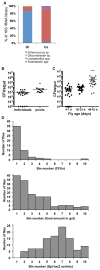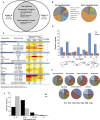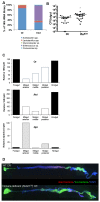Microbiota-induced changes in drosophila melanogaster host gene expression and gut morphology
- PMID: 24865556
- PMCID: PMC4045073
- DOI: 10.1128/mBio.01117-14
Microbiota-induced changes in drosophila melanogaster host gene expression and gut morphology
Abstract
To elucidate mechanisms underlying the complex relationships between a host and its microbiota, we used the genetically tractable model Drosophila melanogaster. Consistent with previous studies, the microbiota was simple in composition and diversity. However, analysis of single flies revealed high interfly variability that correlated with differences in feeding. To understand the effects of this simple and variable consortium, we compared the transcriptome of guts from conventionally reared flies to that for their axenically reared counterparts. Our analysis of two wild-type fly lines identified 121 up- and 31 downregulated genes. The majority of these genes were associated with immune responses, tissue homeostasis, gut physiology, and metabolism. By comparing the transcriptomes of young and old flies, we identified temporally responsive genes and showed that the overall impact of microbiota was greater in older flies. In addition, comparison of wild-type gene expression with that of an immune-deficient line revealed that 53% of upregulated genes exerted their effects through the immune deficiency (Imd) pathway. The genes included not only classic immune response genes but also those involved in signaling, gene expression, and metabolism, unveiling new and unexpected connections between immunity and other systems. Given these findings, we further characterized the effects of gut-associated microbes on gut morphology and epithelial architecture. The results showed that the microbiota affected gut morphology through their impacts on epithelial renewal rate, cellular spacing, and the composition of different cell types in the epithelium. Thus, while bacteria in the gut are highly variable, the influence of the microbiota at large has far-reaching effects on host physiology.
Importance: The guts of animals are in constant association with microbes, and these interactions are understood to have important roles in animal development and physiology. Yet we know little about the mechanisms underlying the establishment and function of these associations. Here, we used the fruit fly to understand how the microbiota affects host function. Importantly, we found that the microbiota has far-reaching effects on host physiology, ranging from immunity to gut structure. Our results validate the notion that important insights on complex host-microbe relationships can be obtained from the use of a well-established and genetically tractable invertebrate model.
Copyright © 2014 Broderick et al.
Figures






References
Publication types
MeSH terms
LinkOut - more resources
Full Text Sources
Other Literature Sources
Molecular Biology Databases
